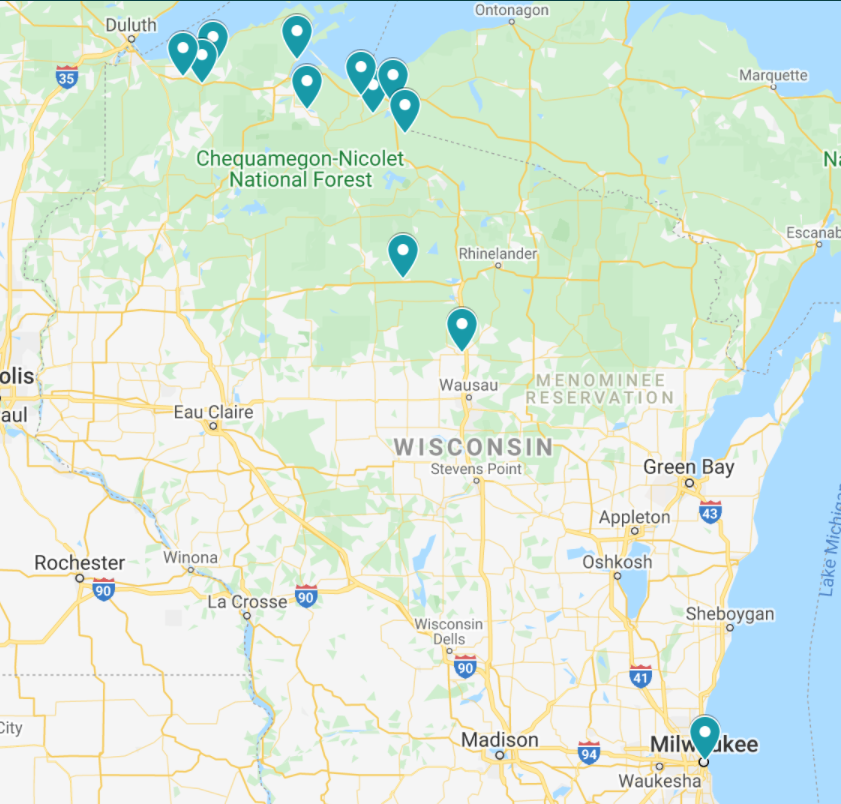
Finnish
Language
Finnish use in Wisconsin today is largely post-vernacular, meaning those with a cultural/heritage connection to the language don’t necessarily speak the language conversationally, but rather use words, songs, and phrases as part of cultural celebration. However, there are efforts to teach younger generations basic Finnish to pique their interest.
Learn Finnish Words and Phrases!
Hei or Moi or Terve — Hello
Mitä kuuluu — How are you?
Suomi — Finland
History
Finnish Communities in Wisconsin
Merrill
Milwaukee
Oma
Oulu
Saxon
Washburn
Brantwood
Brule
Iron Belt
Hurley
Maple
Marengo
Credit to Finns in Wisconsin where not otherwise noted or quoted
Overview
“Finnish immigrants first came to Wisconsin in the 1890s and settled in primarily rural areas. Most settled in 13 counties in northern Wisconsin, three of which, Douglas, Iron, and Bayfield, accounted for half of the state's total Finnish population. Small Finnish communities did exist in Superior, Milwaukee, Ashland, Kenosha, Racine, and West Allis.
In the first wave of settlement, from 1890 to 1910, many Finns were forced to take temporary jobs as laborers before they could purchase farms. Between 1910 and 1925, Finns made intensive efforts to convert former woodlands in northern Wisconsin into productive farmlands. Most of these farms failed. As a result, by World War II, most Finns had stopped farming.”
Source: Wisconsin Historical Society
Image Credit: https://www.wisconsinhistory.org/Records/Image/IM38200
First Arrivals
Finns arrived in the U.S. relatively late compared to other European immigrants, coming into Wisconsin in the 1880s. Farming wasn’t the most fruitful job back in Finland, but as many moved out of agriculture, they were met with poverty and unemployment. The late 1800s was filled with waves of famine and death. Upon arrival in America, most worked as unskilled laborers.
Log cabins were emblematic of Finnish settlers and they can be credited with introducing them to America. They are also known for their saunas.
Image Credit: https://www.wisconsinhistory.org/Records/Image/IM53441
Wisconsin v.s. Minnesota and Michigan
“Although the landscape of the Wisconsin area resembled Finland, economic opportunity was by far the most important factor influencing Finnish settlement patterns in the Western Great Lakes region. For this reason the state, with its limited mining, never attracted the numbers of Finns as did Michigan and Minnesota.” Railroads and rock quarries offered employment opportunities. Michigan and Minnesota had the largest Finnish populations nationally during this time.
Image credit: Finns in Wisconsin, page 17
Logging
“Although the Finns arrived in Wisconsin at the end of the logging boom,” they were knowledgeable when it came to trees.
“Immigrant pioneers had been settling in the state for almost half a century before the Finns began to arrive, and of course the best land was the first taken. Finns therefore had little to choose from except lands in those far-northern counties known as the “cutover.” These were the old logging counties, now offered to the immigrants by railroads, logging companies, and real estate agents.”
Image Credit: Finns in Wisconsin, page 18
Socialism
“Many Finnish workers became active in the American labor movement as socialists, communists, and members of the Industrial Workers of the World — the famed IWW — which primarily organized mining, lumbering, and agricultural laborers before World War I. Their radical approach to labor organization mirrored the Finns’ low social station, as well as their cultural heritage: the Labour Party was founded in Finland in 1899 and adopted Marxist tenets in 1903, developing along revolutionary lines.”
“While several of these workers’ groups still survive, especially in Superior, their history, as well as that of societies long since disbanded, seems to suggest that they have been more successful as cultural and social agencies than as advocates of class struggle.”
This image is of Työmies Publishing Company, a socialist newspaper.
Image Credit: https://www.wisconsinhistory.org/Records/Image/IM55430
Traditions
“The Finns settling in rural Wisconsin maintained a pioneer existence far later than most immigrant groups, building their homes and farms in the traditional styles by traditional methods long after other immigrants had made the transition to American balloon-framed architecture. […] Part of their apparent fondness for traditional ways might also reflect their late arrival: after all, they came to Wisconsin some sixty years after the beginning of the influx of groups such as the Germans and Norwegians, who had been assimilating into American society for over two generations when the Finns began to arrive. […] But perhaps most importantly, the Finns tended to settle together and created little Finlands wherever they went. This cultural reinforcement allowed them to live independently of “foreign” or non-Finnish language and ways; their own language, both written and oral, their associative spirit, their desire to maintain familiar ways under new freedoms found in the United States, permitted the Finns to exist as an independent ethnic community well into the twentieth century.” Co-ops were mainstays in Finnish life.
Image Credit: https://www.wisconsinhistory.org/Records/Image/IM4476
The Oulu Cultural and Heritage Center
View this fantastic documentary by Mirva Johnson (who also happens to be an interviewee!) about Oulu’s efforts to preserve and celebrate their Finnish heritage.
Further Reading and Sources
Building a Place for Finnish Heritage to Thrive
The Oulu Cultural and Heritage Center
Superior teacher gains perspective from Finnish educators
Center for the Study of Upper Midwestern Cultures (CSUMC)
Wisconsin Teachers of Local Culture
The Shift from Finnish to English in Northern Wisconsin
Finns — Milwaukee Encyclopedia









